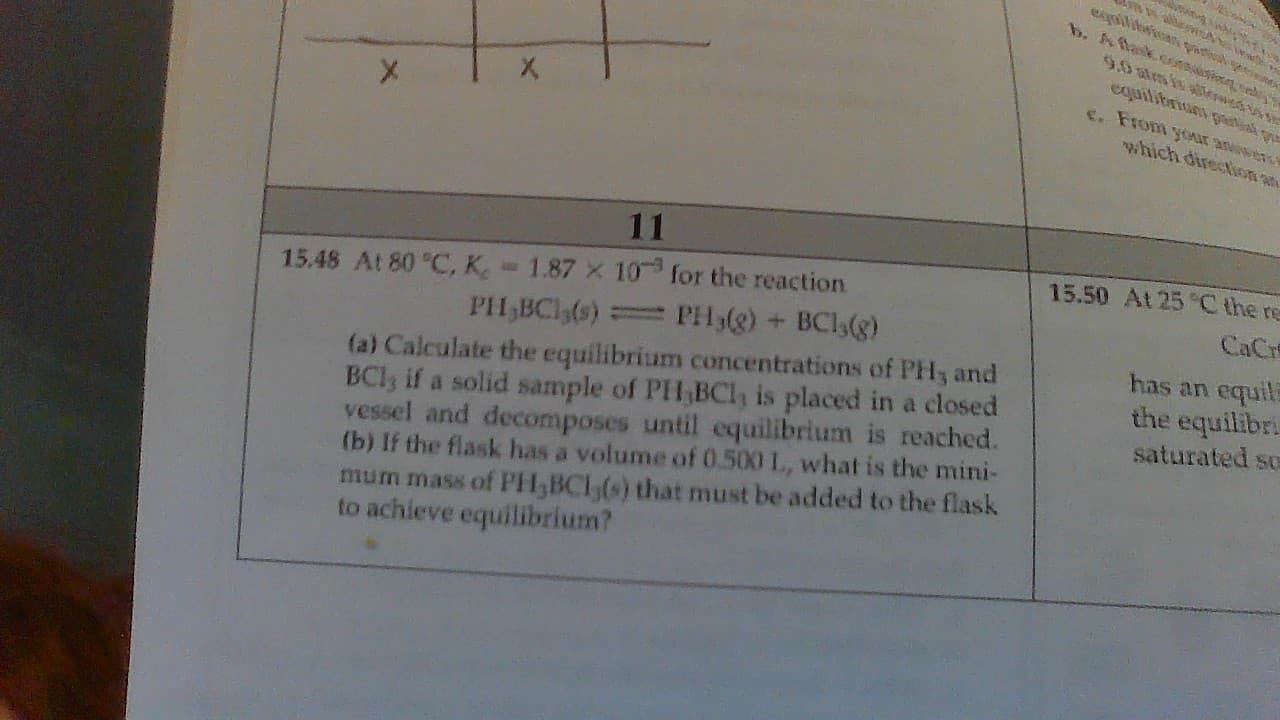b. ak comaitiee equilitrium getia c. From your anwe hich direction 11 15.50 At 25 Cthe re 15.48 At 80 °C, K 1.87 x 10 for the reaction PH3BCl(6) CaCr PH3(g)+BCl(g) has an equila the equilibri saturated so (a) Calculate the equilibrium concentrations of PH, and BCI, if a solid sample of PH,BCl, is placed in a closed vessel and decomposes until equilibrium is reached. (b) If the flask has a volume of 0.500 L, what is the mini- mum mass of PH,BCI () that must be added to the flask to achieve equilibrium?
b. ak comaitiee equilitrium getia c. From your anwe hich direction 11 15.50 At 25 Cthe re 15.48 At 80 °C, K 1.87 x 10 for the reaction PH3BCl(6) CaCr PH3(g)+BCl(g) has an equila the equilibri saturated so (a) Calculate the equilibrium concentrations of PH, and BCI, if a solid sample of PH,BCl, is placed in a closed vessel and decomposes until equilibrium is reached. (b) If the flask has a volume of 0.500 L, what is the mini- mum mass of PH,BCI () that must be added to the flask to achieve equilibrium?
Chemistry: Principles and Reactions
8th Edition
ISBN:9781305079373
Author:William L. Masterton, Cecile N. Hurley
Publisher:William L. Masterton, Cecile N. Hurley
Chapter12: Gaseous Chemical Equilibrium
Section: Chapter Questions
Problem 36QAP: At a certain temperature, K=0.29 for the decomposition of two moles of iodine trichloride, ICl3(s),...
Related questions
Question
see picture!!

Transcribed Image Text:b. ak comaitiee
equilitrium getia
c. From your anwe
hich direction
11
15.50 At 25 Cthe re
15.48 At 80 °C, K 1.87 x 10 for the reaction
PH3BCl(6)
CaCr
PH3(g)+BCl(g)
has an equila
the equilibri
saturated so
(a) Calculate the equilibrium concentrations of PH, and
BCI, if a solid sample of PH,BCl, is placed in a closed
vessel and decomposes until equilibrium is reached.
(b) If the flask has a volume of 0.500 L, what is the mini-
mum mass of PH,BCI () that must be added to the flask
to achieve equilibrium?
Expert Solution
This question has been solved!
Explore an expertly crafted, step-by-step solution for a thorough understanding of key concepts.
Step by step
Solved in 5 steps with 5 images

Knowledge Booster
Learn more about
Need a deep-dive on the concept behind this application? Look no further. Learn more about this topic, chemistry and related others by exploring similar questions and additional content below.Recommended textbooks for you

Chemistry: Principles and Reactions
Chemistry
ISBN:
9781305079373
Author:
William L. Masterton, Cecile N. Hurley
Publisher:
Cengage Learning

Introduction to General, Organic and Biochemistry
Chemistry
ISBN:
9781285869759
Author:
Frederick A. Bettelheim, William H. Brown, Mary K. Campbell, Shawn O. Farrell, Omar Torres
Publisher:
Cengage Learning

Introductory Chemistry: A Foundation
Chemistry
ISBN:
9781285199030
Author:
Steven S. Zumdahl, Donald J. DeCoste
Publisher:
Cengage Learning

Chemistry: Principles and Reactions
Chemistry
ISBN:
9781305079373
Author:
William L. Masterton, Cecile N. Hurley
Publisher:
Cengage Learning

Introduction to General, Organic and Biochemistry
Chemistry
ISBN:
9781285869759
Author:
Frederick A. Bettelheim, William H. Brown, Mary K. Campbell, Shawn O. Farrell, Omar Torres
Publisher:
Cengage Learning

Introductory Chemistry: A Foundation
Chemistry
ISBN:
9781285199030
Author:
Steven S. Zumdahl, Donald J. DeCoste
Publisher:
Cengage Learning

Chemistry by OpenStax (2015-05-04)
Chemistry
ISBN:
9781938168390
Author:
Klaus Theopold, Richard H Langley, Paul Flowers, William R. Robinson, Mark Blaser
Publisher:
OpenStax

Chemistry: Principles and Practice
Chemistry
ISBN:
9780534420123
Author:
Daniel L. Reger, Scott R. Goode, David W. Ball, Edward Mercer
Publisher:
Cengage Learning

Chemistry: The Molecular Science
Chemistry
ISBN:
9781285199047
Author:
John W. Moore, Conrad L. Stanitski
Publisher:
Cengage Learning